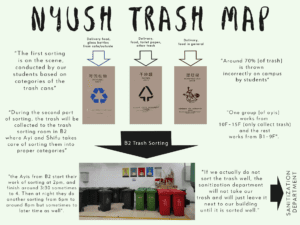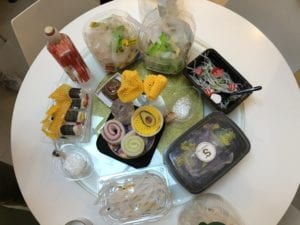The Trash Map
Through out the week, we walked around campus to track the trash route and found some interesting facts. There are actually two companies that sorts trash in the NYU Shanghai academic building. One is responsible for the sorting of 10F-15F and they cater more towards professors and staffs of NYU Shanghai since most of the are located on those floors. They do not do any sorting of trash but rather they only take out the trash and place them in B2. Meanwhile, another company, which we see more often with the cream colored shirts and pants constantly cleaning the bathrooms are responsible for floors 9F-B2. The ayis collect trash and place them in B2 as well for the final sorting. There will be two to three ayis at B2 who will sort the trash starting from 2pm to around 4pm and then they will sort another round of trash from 6pm to 8pm.
Sproutworks on the other hand, do not work with any of the trash sorting companies in the academic building but rather they have their own system. They take care of their own trash in the cafe and B1 cafeteria which is why we see different types of trashcans in those areas. They do their own sorting of trash but mostly following the Shanghai trash regulation rules.
Below is a trash map my group and I have created to represent the trash route at NYU Shanghai:

The Art Installation
The art installation was what I believe a huge success for our group due to our great collaborative work and creative minds. Thankfully, we had a good amount of plastic waste to create our art installation and the final result was amazing. Initially, we were struggling to come up with an idea because normally plastic trash waste isn’t someones medium to create art with. However, since our purpose was to raise awareness of the plastic waste, I thought about creating a structure of a person with plastic trash in its stomach. This idea was also connected to the movie we watched, “Bag It” in the beginning of our course which talked about humans and animals actually consuming either plastic chemicals, particles or plastic itself without knowing it.
We looked around the AB for some more material then Eva brought out a round spinning table that you would normally see in a Chinese restaurant that sets at the center of the table and you could spin it around to get the food you want. So we transformed our idea into a dinning table with food that are created all by plastic trash. We had sushi made out of styrofoams, noodles made out of plastic bags, along with table decorations made from all types of plastic.
We decided to locate our art installation in the cafeteria near the trash sorting bins because there is high traffic around that area and more people would be able to see it. We also wrote slogans like “You are trash”, “我不吃塑” which means I do not eat plastic in English but in Chinese it also means I’m a vegetarian since the word 塑 and 素 are pronounced the same way. We hope that by having this installation next to the trash bins we are able to raise awareness on plastic waste disposal especially with the take out boxes and just to set out a reminder for people to always reduce, reuse, and recycle.

Leave a Reply